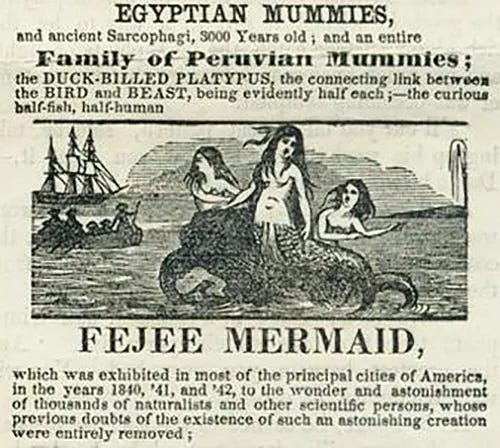In terms of favorite exhibits at the International Cryptozoology Museum in Maine, the Feejee Mermaid didn’t even crack Little Bean’s top five - a testament to just how much is crammed into that Portland-based museum, but also because that particular item is, uh, sort of ghastly.
Also, surprisingly interesting!
For her part, my daughter was far more interested in Nessie, Bigfoot Casts, Mothman and the giant stuffy squid. (Sidenote: She’s working on an interview with Loren Coleman, the founder of the museum.)
But I was drawn to the mermaid, in part because - there’s no delicate way to say this - the mermaid is a Hollywood prop, specifically a prop used for the 1999 television film, P.T. Barnum, that the museum was able to secure. That prop, likely an amalgamation of paper-mache, wire and paint is still pretty darn lifelike, not to mention grotesque.
Back in 1842, when Barnum created a worldwide sensation by bringing the “real” Feejee Mermaid to his museum in New York City, the mermaid was actually a taxidermy monkey head sewn onto the body of a large fish. In typical P.T. Barnum fashion, he advertised the exhibit as you might expect Disney to today, as a beautiful, buxom woman with flowing hair and shining tail.
So horrified were unsuspecting attendees that one wrote that the Feejee Mermaid was the “incarnation of ugliness.”
None-the-less, like all things Barnum, the mermaid was still a hit and drew observers from around the world. Barnum gave it a back story, sent fictional letters to newspapers to drum up interest and even employed a fictional “Mr. Griffin” as an expert on all things mermaid.
The actual story, it’s thought, is that the mermaid was built by a Japanese fisherman who sold it to a sailor, which was a pretty common origin story for a lot of the mermaid finds going around at the time.
Here’s a link to a really great article by Live Science that traces the Asian origins and folklore behind Feejee Mermaids and how the mythology came to be spread by Barnum and others in the mid-19th Century - The Feejee Mermaid History
As for the mermaid made famous by Barnum, in his biography he described it as an “ugly dried-up, black-looking diminutive specimen, about three feet long. Its mouth was open, its tail turned over, and its arms thrown up, giving it the appearance of having died in great agony.”
Here’s an illustration of Barnum’s mermaid next to the prop on display at the Cryptozoology Museum. Looks pretty good, and creepy, right?
The museum’s mermaid was sculpted and painted by Canadian make-up artist and special effects wizard Erik Gosselin and used in the movie. (By the way, the movie is the one with Beau Bridges, not that other one with Hugh Jackman.)
The legend of Feejee Mermaids has existed for thousands of years with descriptions of a genderless, human-like, monkey, fish hybrid appearing in the Nihon Shoki, one of the oldest books in Japanese history. The book was compiled in 720 AD and contains Japan’s early mythology.
So Barnum didn’t create the mermaid, he just made it famous.
Meanwhile, back in Portland, the little mermaid prop remains a highlight of the museum and a unique throwback to a showman’s flair for cashing in on the unusual.
Is the Feejee Mermaid a proper cryptid? Of course it is! You see, Barnum’s original mermaid was lost in a fire, but since then, many many more Feejee Mermaids have been sighted. And perhaps one of them, just one, might be the real deal. One never knows with these things. Best to keep looking!






Loved this story. Next time I'm up in Maine, I am definitively going to this museum. Keep up the good work!!!
Good ole P.T. Barnum!